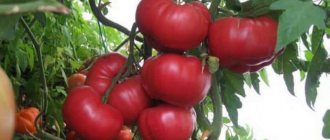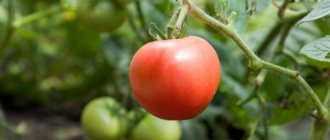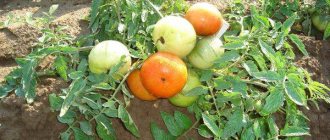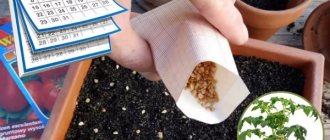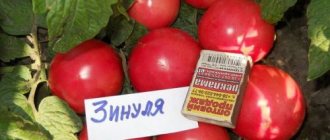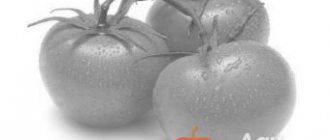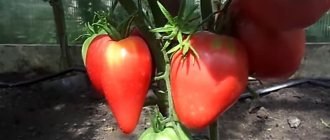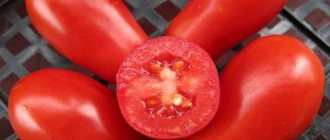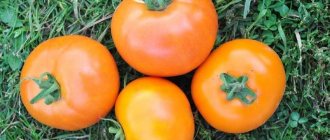Taste qualities of fruits
Experts note that the Nastena hybrid is a high-yielding variety.
Each flower cluster can produce 6 to 8 delicious fruits. The peel is quite thin, but at the same time dense, it allows Nastena to be transported over long distances. The fruits have a rounded-flattened shape; the weight of one tomato can reach 300 grams. The purpose of the fruit is universal. The main direction is salad, but tomatoes are also good when pickled. The shape of Nastena tomatoes is flat-round with slight ribbing. The fruit size is closer to average. The fruits weigh from 90 to 150 g.
The fruits are perfectly stored. In a cool room or in the refrigerator, ripe tomatoes do not lose their presentation for 1.5 months. When harvested, 70-90% of tomatoes are marketable. The declared yield is from 170 to 500 c/ha.
Bushes of the determinate type grow in the soil slightly higher than 1 m, with little foliage. The leaves are green, not large. In terms of ripening, the hybrid is early ripening. You can expect ripe tomatoes 3 months after germination (95-100 days). From 6 to 8 tomatoes are formed in the brush. When pouring fruit, the bush needs support in the form of a wooden or plastic stake.
To get a good harvest, seedlings need to be planted in the ground at the age of 55 days. When planting, follow the recommended layout of planting holes of 50 by 60 cm. To obtain large-sized tomatoes, plant the bushes in 1 stem.
The taste of the fruits of the Nastena F1 variety is assessed as good. Tomatoes have a universal purpose. They are used for salads, first and second courses. Due to its good density, the pulp does not soften during heat treatment. Nasten's tomatoes are suitable for whole-fruit canning and other homemade preparations.
Nasten's tomatoes are among the first to bear fruit. The period from the appearance of sprouts to the ripening of tomatoes is 95 - 98 days. The harvest begins in July. Fruiting is extended, lasting until September.
From 1 sq. m of planting, 16 - 18 kg of fruits are harvested. The yield from one bush of the Nastena F1 variety is 5 - 8 kg. When grown on an industrial scale, you can harvest from 176 - 507 c/ha. These are high indicators compared to standard varieties. For example, the famous tomatoes Nepravda and Dar Zavolzhye under similar conditions bring a yield of about 159 - 495 c/ha.
Nasten tomatoes are picked ripe or at the stage of technical maturity. The crop ripens without problems at room temperature. The yield of marketable products ranges from 69 to 90%. Due to the compacted skin, Nastena F1 tomatoes are well transported. The shelf life of the crop at home is up to 45 days.
Tomato Nastena F1 is one of the most popular early ripening varieties. The variety received love from gardeners for its high yield, small, compact bush and ease of care. Due to its high yield, the variety is grown on an industrial scale and in summer cottages.
For most summer residents who grow tomatoes, it is important how many tomatoes can be harvested from one bush. In search of the necessary information about the variety, you have to spend a lot of time on the Internet. For many new varieties it is very difficult to find reviews and verify its value.
From 1 m2 they harvest 6-8 kg in open beds, in greenhouse conditions 11-14 kg.
Reviews of tomato Nastena F1
It’s difficult to find reviews about the Nasten f1 tomato on the Internet. The hybrid is new and there is not much information about it.
Svetlana, Penza region
This season I tried a new hybrid for me, Nastena F1. The characteristics and description of the variety convinced me. I grew it in open ground and was one of the first to ripen. The fruits are all even, of the same size, good taste with juicy, fleshy pulp. I was completely satisfied with the variety; the entire harvest was eaten fresh. I will definitely plant it next season.
Elena, Ryazan
I have been growing this hybrid for the fifth year in a row. I like the taste, satisfied with the yield, shape and size of the fruit.
Marina, Lugansk
I added this variety to my favorites. This hot summer, my Nastena has pleased me with a decent harvest without much care. It grew in the shade of a fence on sandy soil.
Rimma, Barnaul
For three years in a row we have been enjoying the delicious fruits of this hybrid. Next year I will plant it again, since the variety is very unpretentious and bears fruit well with a minimum of care on my part.
Anastasia, Krasnoyarsk
I have already had 3 attempts to grow seedlings of this variety. All three were unsuccessful. Every year the seedlings died from blackleg. Other varieties grow well for me.
Detailed description of the variety
Nasten tomatoes are an early-ripening hybrid bred by Russian scientists in 2008. During testing, the variety showed high yield and unpretentiousness, thanks to which the plant began to be grown on an industrial scale.
Tomato Nastena F1 is a determinate variety (growth limitation). An adult plant forms a sparsely leafed, powerful bush up to 1 m high. Thanks to the sparse dark green foliage, the bush is well ventilated, and each fruit receives the required amount of sunlight.
Tomato Nastena, according to gardeners, is an early ripening variety. No more than 3 months pass from emergence to harvest. The first flower raceme grows above the 6th leaf, the subsequent ones appear every 2nd leaf.
Nastena F1 tomatoes are a high-yielding variety. Each flower cluster produces from 6 to 8 juicy, tasty fruits. The fleshy, red pulp is surrounded by a dense but thin peel, thanks to which the crop is well transported over long distances and has good shelf life.
The round-flattened, red fruits weigh up to 300 g. Thanks to the small number of seeds, the Nastena tomato variety is used for whole canning and preparing vegetable salads.
Description of tomato variety Nastena with photo
Nastena's tomato is a first generation hybrid (F1), bred by breeders from production. In 2005, an attempt was made to include this variety in the register of selection achievements. After this, the hybrid was successfully tested. Recommended for cultivation in Central Russia (Black Earth regions) - not only in a greenhouse, but also in open beds.
Characteristics of the Nastena tomato variety:
- determinate (grows to a certain height);
- medium height (up to 100-120 cm);
- early ripening (tomatoes begin to ripen in 95-100 days).
The bush is tall, but the shoots are not very strong, so they require staking. The foliage is average. The leaves are large in size and rich green in color. The flowers are small, yellow, and arranged in simple inflorescences. The first cluster with fruits is formed already above the 6-7th leaf, and then every 2. Usually 5-7 fruits are formed on the cluster. The peduncle has an articulation.
Important! Nastena tomatoes should not be confused with the Nastenka variety. These varieties differ significantly in the size of the bush, color, shape and taste of the fruit.
Description of fruits
Nasten tomatoes have a classic round shape, slightly flattened at the top and bottom. The surface is glossy, almost completely smooth, with slight ribbing closer to the stalk. The color is bright red (unripe tomatoes are light green).
On average, the weight is 100-150 g, sometimes tomatoes grow up to 300 g, with a diameter of 6-8 cm. The pulp is very juicy and dense. The taste is good, there are sweet tones with a slight sourness. The fruits have from 4 to 6 seed chambers. There is no need to collect seeds. Since the Nastena tomato is a hybrid and not a variety, new bushes may not form fruits.
Nasten tomatoes have a very attractive, bright color
Resistance to diseases and pests
For every summer resident, this information is very important, because parasites and illnesses can ruin the entire harvest and work in a couple of days. But with “Nastena” you have nothing to fear - the hybrid has excellent resistance to the most common diseases, and insects do not bother it due to its early ripeness. To eliminate all risks, for prevention, the site is well prepared before planting and sprayed with a weak solution of manganese once every couple of weeks.
Nasten F1 tomatoes are resistant to verticillium and other nightshade diseases. Ventilating the greenhouse, weeding, and controlling soil moisture will help protect plants from damage. To combat diseases, the drugs Topaz, Hom, Ridomil are used.
Serious damage to plantings is caused by pests: aphids, thrips, mole crickets, spider mites. Pests are repelled using folk remedies: tobacco dust or wood ash is sprayed, plants are sprayed with infusion of wormwood or onion peels. If there are too many pests, use insecticides Iskra, Fufanon, Fitoverm. The drug is dissolved in water and the tomatoes are treated leaf by leaf.
Features of care and planting
Even inexperienced gardeners can grow tomatoes of the Nastena variety on their plot. The main thing is to choose the right place for the plant and prepare the bed in advance. When grown in the southern region of the country, determinate tomatoes can simply be sown in the ground, but in the northern regions it is worth starting with growing seedlings. In order for the seedlings to be strong and healthy, you should choose high-quality planting material. It is equally important to prepare the soil. The best option for Nastena tomato seeds is a mixture of three parts peat and one part sand.
The next stage is preparing the seeds. To disinfect, the seed should be soaked for 10-15 minutes in a weak solution of potassium permanganate. Another option is to use warm water and hydrogen peroxide. For 100 milliliters of water you will need 3 milliliters of peroxide.
The best option for planting is peat cups. However, you can also use plastic containers. Before sowing tomatoes in them, you should scald them with boiling water. Afterwards, you need to fill the container with soil, water it a little, make holes for the seeds, and then sprinkle it with soil and moisten it with a spray bottle. Experts advise covering the crops with film or glass. This will create a microclimate suitable for seedlings. When the first shoots appear, the shelter can be removed and the seedlings can be placed in a sunny place. Additional lighting may be needed, because in spring the day is short, and without 12-hour daylight the seedlings will become very elongated and weak.
As soon as the tomato has three leaves in addition to the cotyledons, the seedlings need to be pruned. Before planting the plant in a permanent place, it is important to harden it off. To do this, you need to take it out into the open air every day. On the first day it should be no longer than five minutes. Every day it is worth increasing this time by another 3-5 minutes.
Varietal characteristics
If all agrotechnical rules are followed, gardeners say, about 15 kilograms of crop can be harvested from one square meter. Productivity, by the way, depends not only on the varietal characteristics of Nastena, but also on climatic conditions. So, if you decide to grow tomatoes under a film cover or in a greenhouse, fruiting will increase noticeably. However, it is worth noting that juicier and sweeter tomatoes grow in open ground.
It is also worth saying that minor climate changes and high humidity over a short period of time are not terrible for this variety. Nastena's tomato is also resistant to late blight, verticillium, and alternaria.
To ensure that Nastena does not suffer from diseases characteristic of the nightshade family, preventive measures should be taken in a timely manner. For example, experts advise cutting off the lower leaves of bushes so that they do not come into contact with the ground. Timely weeding will also be required. Of course, the greenhouse in which Nastena grows must be ventilated. If you follow all these simple rules, you can rest assured: the tomato will not be afraid of either diseases or pests.
Nasten tomatoes, according to gardeners, are a high-yielding variety. Subject to agrotechnical rules, from 1 sq. m you can remove up to 15 kg of juicy and sweet harvest. Yields are affected not only by varietal characteristics, but also by climatic conditions. When growing tomatoes under film cover, fruiting increases. But when growing tomatoes in open beds, the fruits grow juicier and sweeter.
The Nastena tomato variety tolerates minor climate changes and high humidity. The variety also has strong immunity to late blight, Alternaria and verticillium.
To protect tomatoes from the sudden onset of diseases, it is necessary to take preventive measures:
- observe crop rotation;
- tear off the lower leaves so that they do not touch the ground;
- carry out timely weeding;
- Before planting seeds, treat the soil;
- ventilate the greenhouse more often;
- purchase only high-quality planting material.
If you follow the rules of care, the tomato is not afraid of either diseases or insect pests.
The Nastena F1 tomato variety, judging by the reviews and photos, consists of only advantages. These include:
- high yield, the variety can be grown for sale;
- large fruit;
- forms a low leafy bush;
- good presentation and taste;
- small number of seeds;
- ease of care;
- good transportability and keeping quality;
- resistance to diseases and cold snaps;
- can grow in open beds and under film cover;
- does not form stepchildren.
No deficiencies were identified in the variety.
New hybrid Nastena F1 description
The Nasten hybrid is already 10 years old, it was bred by breeders Yu.I. Panchev and V.V. Zazimko for use in open ground. The variety was tested in the Central Black Earth region, recommended for personal consumption and cultivation for sale in small farms.
The first generation hybrid is not inferior to its foreign analogues in disease resistance. Shows good resistance to a number of diseases:
- Verticillium.
- Late blight.
- VTM.
- Alternaria.
The undoubted advantages include the hybrid’s insusceptibility to temporary drops in temperature and waterlogging of the soil.
Advantages and disadvantages
Pros:
- early ripeness;
- presentable tomato presentation;
- transportability and keeping quality;
- friendly germination;
- endurance to adverse factors;
- good immunity.
Minuses:
- need for fertilizing.
As you understand, the hybrid is quite good, and so that you can accurately decide on your choice, we will once again mention point by point what you should pay attention to.
But does this wonderful hybrid have any negative sides? If you can call it that, that is.
- any hybrid variety does not produce a good harvest in the second year, so there is no point in collecting seeds;
- demanding on the amount of fertilizing, but you can use conventional complex preparations throughout the entire growing season;
So, as you can see, a decent tomato. If you are interested in it, then we advise you to also get acquainted with the method of growing it; it is quite simple, but still everyone should study it.
- productive tomato - according to reviews, it can produce, with good care, up to 18 kg per square meter;
- saves time - there is no need to pinpoint, shape, thin out bushes, supports - as desired;
- does not get sick and is not afraid of insects;
- the fruits are very tasty and suitable for both canning and eating fresh;
- can be stored for a long time and transported well;
- has good resistance to low temperatures.
Description and characteristics of the variety
The tomato variety Nastenka is registered by the agro and peasant (farm) farm Kondakov S.N. Year of inclusion in the State Register - 2008. Recommended for growing under film and in the garden in all regions. Planting in permanent greenhouses is possible.
Description of the bush
Tomato Nastenka forms a low, semi-standard bush with determinant (limited) growth:
- in the garden - 70 cm;
- in the greenhouse - 90 cm.
The shoots are thick and strong. Even seedlings always turn out stocky and do not tend to stretch out. The leaves are green, small, juicy, with clear veins. With regular watering, they accumulate a sufficient supply of moisture so as not to wither in the heat.
An average number of shoots and leaves are formed. This makes the bush light, it is well ventilated, which reduces the likelihood of infectious diseases.
Fruit characteristics
Nastenka tomatoes are collected in simple clusters of 5-8 pieces. They are beautiful, which can be clearly seen in the photo; at the technical stage they are green, after full ripening they are deep pink. The shape of tomatoes is similar to a heart, but not a stylized one, but a real one - a short oval with a swelling in the middle and a slight narrowing at the end. There are more than 6 chambers, the ribs are weakly expressed, and there are few seeds.
The weight of the fruit depends on whether the bush will be formed and the ovaries pinched:
- if these operations are ignored, the weight is about 120-130 g, the plant is literally strewn with medium-sized tomatoes;
- with careful pinching and maintaining 2-3 trunks, the weight increases to 200, and in some fruits - 300 g;
- By adding normalization of the ovaries (pinching the brushes) to the removal of the lateral processes, you can grow half-kilogram giants.
The taste of Nastenka's fruits is delicate and sweet. Those who have planted the variety claim that it is one of the best pink tomatoes for problematic climates.
The pulp contains enough juice and is grainy when cut. The skin is strong, but not rough. Tomatoes are eaten fresh, processed into juice, paste, salted, canned whole, and prepared in winter salads.
Productivity
2-2.5 kg are harvested from a bush per season. Thanks to resistance to late blight, new fruit clusters can appear until it gets cool outside, and tomatoes ripen until frost.
The harvest per square meter depends on the planting density. Maximum of 10-12 kg per 1 sq. m. achieved when grown in greenhouses or under film, maintained in 1 trunk. The weight and number of tomatoes do not affect the overall yield from the bush.
The marketability of fruits can be significantly reduced by uneven watering - tomatoes are prone to cracking.
Features of cultivation and storage
The quality and quantity of the harvest depends on the right location and timely prepared bed. The Nastena variety is so unpretentious that it can be grown by novice gardeners.
Growing seedlings
It is profitable to grow the determinant variety Nastena; it is capable of setting fruit in any conditions. When grown in the south, the seeds are sown directly into the ground; in regions with short summers, Nasten F1 tomatoes, according to gardeners, are better grown through seedlings.
To obtain strong and healthy seedlings, it is necessary to prepare the soil and planting material. Soil for planting seeds can be bought at the store, or you can prepare it at home. To do this, mix peat and sand in a ratio of 3:1.
To prevent an adult plant from getting sick, the seeds must undergo a disinfection stage before sowing. To do this, the seed can be soaked for 10 minutes in a weak solution of potassium permanganate or a warm solution of water and hydrogen peroxide (100 ml of water and 3 ml of peroxide).
For planting, you can use peat or plastic cups, 10 cm high boxes or peat tablets. When planting in boxes and plastic cups, the containers must be scalded with boiling water.
The prepared containers are filled with nutritious soil, the seeds are spilled and buried to 1.5 cm. The crops are covered with polyethylene or glass to create a microclimate favorable for germination and put in a warm place. After the emergence of seedlings, the shelter is removed and the seedlings are transferred to a well-lit place. Since the seeds are sown at the end of March, it is necessary to install additional lighting.
After the appearance of 3 true leaves, the seedlings are planted in separate containers of larger volume, deepening the plant to the cotyledon leaves.
Before transplanting tomatoes to a permanent place, it is necessary to harden them. To do this, the tomatoes are taken out into the open air, for the first time for 5 minutes, then increasing the stay time by 5 minutes daily.
Transplanting seedlings
Seedlings ready for planting should be 30 cm high and have a flower cluster. Before planting, dig up the soil, add humus, wood ash and crushed eggshells.
In the prepared bed, holes are made at a distance of 50 cm from each other. The best predecessors for the Nasten tomato are legumes, cereals and pumpkin crops. After potatoes, peppers and eggplants, tomatoes can be planted after 3 years.
The planting hole is shed generously with settled, warm water. Next, the seedlings are carefully removed from the cup and planted at right angles to the ground. The plant is covered with earth, compacted, watered and mulched. You can use straw, grass clippings or sawdust as mulch. Mulch is an assistant to the gardener, as it:
- retains moisture;
- prevents weeds from germinating;
- nourishes the soil;
- protects the root system from sunburn.
To prevent the plant from being attacked by insect pests, you can plant herbs, calendula and marigolds next to the tomatoes.
Tomato care
Caring for the Nastena tomato variety is simple; it involves watering and fertilizing.
The first watering with warm, settled water is carried out 2 weeks after planting the seedlings. Further, abundant irrigation is necessary:
- during flowering;
- during the period of fruit formation and ripening.
Since tomatoes are a moisture-loving plant, 3 liters of water are poured under each bush. After watering, the soil is loosened and mulched.
Fertilizing is necessary for the Nastena tomato to form large fruits. Fertilizers are applied during flowering, during the formation and ripening of fruits. Complex mineral and organic fertilizers are used as fertilizer.
Tomato variety Nastena greatly simplifies the gardener’s work:
- he does not develop stepchildren;
- it does not need to be formed;
- A garter is necessary only if a large number of fruits are formed on the hand.
Additional care when growing in a greenhouse:
- regular ventilation;
- compliance with temperature and humidity conditions;
- artificial pollination;
- timely removal of weeds;
- disease prevention;
- Regular collection of fruits to increase fruiting.
For better fruit set, greenhouse tomatoes require artificial pollination. To do this, pollinating insects are attracted, frequent ventilation is carried out in windy weather, and the bush is shaken daily.
In order for the plant to receive more light, it is necessary to remove the leaves under each flower ovary. You can cut no more than 3 leaves per week.
The hybrid is intended for planting:
- in greenhouses in regions with temperate climates;
- in open beds in the south;
- in Siberia and the north in protected heated greenhouses.
It is grown traditionally - through seedlings. The bushes are transplanted to permanent plots upon reaching 50-55 days.
The soil is fertilized in advance - organic matter and minerals are added per 1 m2:
- 1 bucket of compost;
- 20-30 g of superphosphate;
- 10 g potassium sulfate.
How to care:
- bushes form into 2 shoots;
- stepchildren 1 time in 10 days;
- water at the root 2 times a week, the water norm is 6-8 l;
- Root and foliar fertilizers are used.
It is necessary to fertilize during flowering, setting and ripening. For nutritional components, use 1:10 diluted litter. Mineral supplements that are used include:
- phosphorus-potassium mixture;
- saltpeter;
- nitrogen compounds;
- boric acid.
Growing rules
The agricultural technology for growing tomatoes of the Nastenka variety is quite simple and traditional for determinate plants. However, despite a number of advantages, there are also disadvantages. When growing seedlings, a gardener must have certain skills, while beginners must be prepared for difficulties. It is necessary to clearly know and adhere to the rules of planting seedlings, transplanting tomatoes, as well as further caring for them.
Planting seedlings
Nastenka tomatoes are recommended to be grown in seedlings even in the Southern regions. The production of seedlings begins at the end of February or early March, sowing seeds in shallow containers filled with purchased ready-made soil, pre-treated and filled with the necessary elements. It is better to purchase seeds for sowing in specialized stores that sell them in processed form.
When using garden soil:
- It is necessary to disinfect it by heating or a solution of potassium permanganate.
- Before planting, the soil is watered and compacted a little.
- The seed placement depth is no more than 1 cm.
- Before germination, the container is covered with glass or film to retain moisture. It is kept at temperatures up to 25 ºС.
- With the emergence of seedlings, the shelter is removed, and the temperature is lowered for a week to 14 - 16 ºС so that the seedlings do not stretch out. Subsequently, the temperature is maintained at 20 – 22 ºС.
- Watering is carried out as the soil dries with warm water.
- Seedlings dive when 1-2 true leaves appear in separate seedling pots, cups or other containers with a volume of at least 8x8 cm.
Advice! When picking, the root of the seedling is pinched to stimulate the development of lateral roots.
To get strong, healthy seedlings, you need sufficient lighting for 15-16 hours, regular watering without waterlogging and lowering the air temperature at night.
Tomato transplant
At the age of 60-65 days, Nastenka tomato seedlings are planted in a permanent place in open ground or a greenhouse. By this time, the tomato seedling should have 6-8 true leaves and at least one flower cluster. Planting dates directly depend on the type of shelter, weather conditions of the region and last from early April to June.
Plants are planted less often in greenhouses than in open ground. On average, per 1 m² of protected soil, the consumption of seedlings is 3 plants, open - 4. Plants are planted at a distance of 40-45 cm from each other with row spacing of 60-70 cm.
Warning! With a higher planting density of tomatoes, lighting and ventilation deteriorate, which contributes to the development of diseases and reduced fruit set.
Tomatoes are planted in open ground in sunny, protected from the north wind, non-flooded areas with fertile soil of a loose structure. Best predecessors:
- beans;
- peas;
- cabbage;
- corn;
- forage grasses.
We suggest you read: How to prepare soil for growing seedlings of tomatoes and peppers at home
Re-growing tomatoes after nightshade crops, peppers, and eggplants is not allowed due to the risk of the spread of specific diseases.
Tomatoes are planted in soil amended with organic and phosphorus-potassium fertilizers in the fall.
The holes are dug in such a way that the tomato seedlings fit in them to the full height of the root ball without damaging it, and a depression is formed for watering. Plant watered seedlings in well-moistened holes.
Attention! To reduce transplant stress, use growth stimulants in accordance with the manufacturer's recommendations. And to improve fertilization of the ovaries, spray with boron solution.
Growing the Nastenka variety involves the same agrotechnical measures as when caring for other determinate tomatoes. Regular watering, which is carried out depending on the condition of the soil 1-2 times a week to the entire depth of the root system, has a positive effect on yield growth.
For the first feeding, use a solution of mullein or complex fertilizers with nitrogen, for the next - with a predominance of phosphorus and potassium. Fertilizing is combined with watering to prevent excess moisture. Mulching with sawdust and straw helps conserve moisture and protect row spaces from weeds, but this creates problems when loosening the soil.
Nastenka tomatoes produce a limited number of side shoots. In open ground, pinching may not be necessary, but in a greenhouse some of the shoots need to be removed to form a bush of no more than 3 stems. It is better to tie the tomato variety Nastenka to a support.
Planting in open ground occurs in seedlings. Seeds are placed in boxes with soil in early March. If it is possible to obtain an early harvest (relevant for the southern regions), seedlings can be sown in the second ten days of February. In this case, it is necessary to provide additional lighting with lamps.
Seedling method
Nastya tomatoes have 100% germination rate, so beginners can easily cope with the procedure of growing seedlings. During the first week before emergence, abundant watering should be provided, but when the stem first appears, it should be reduced, otherwise the plants will get sick or even die.
When 3 true leaves appear, the seedlings are divided into separate containers and sent to the shade for several days. This variety loves feeding. Therefore, during the seedling period, it is necessary to ensure timely application of mineral fertilizers in compliance with the dosages indicated on the packaging.
Top dressing
10 days before planting in open ground, you need to harden the plants: take them out onto the loggia or open veranda for a couple of hours. Every day the hardening interval can be increased. In good weather conditions, seedlings can be left in the fresh air around the clock.
Description of agricultural technology for growing tomatoes Nastenka:
- The time for planting seedlings in the ground is 2-3 ten days of May. Before planting, you need to make sure that there is no chance of frost;
- For planting, you do not need to prepare pegs and garter material. It is worth paying attention to the choice of location when planting is carried out in open ground. The site should be on the sunny side, protected from drafts. Also, you should not choose a damp place with close groundwater;
- The holes are arranged in a checkerboard pattern. To avoid thickening between the branches, the planting density should be 5 bushes per 1 m2. The distance between the holes is 40-50 cm, the depth of the holes is 20 cm;
- The bottom of the hole can be lined with a thin layer of mineral fertilizers. The plant needs to be installed in the center along with an earthen lump from the container for growing seedlings;
- During the fruiting period, special attention should be paid to watering, loosening and removing weeds:
- A week after planting, water the tomatoes 2 times a week with warm, settled water, without flooding the roots and stem. Water consumption – 2 l/bush. With the onset of flowering, water consumption is doubled. From the moment the first fruits form, watering should be reduced to once every 4 days with a water consumption of 3 l/bush. During the ripening period, watering is reduced to a minimum (no more than once a week). The peculiarity of the “Nastenka” variety is that with excessive watering during ripening, the fruits crack;
- Feeding. Phosphorus has a beneficial effect on the development of the root system. Potassium increases disease resistance and improves the taste of fruits. Mineral fertilizers can be replaced with ash.
- Loosening is very important during the period of active growth. It is combined with the removal of weeds and lower leaves. These measures improve soil aeration, reduce the risk of plant infection and root rotting from excess moisture, and increase plant growth and development;
- In harsh climates, mulching the soil is necessary to protect the roots from freezing. Straw is best suited for these purposes.
Mulching
Another Nastenka
The wide selection of varieties is sometimes misleading with similar names. Summer residents are often confused. For example, along with the Nasten hybrid from the Russian Seeds company, there is the Nastenka variety from.
Authors of Nastenka: M. A. Kotelnikova, S. N. Kondakov. This variety was included in the state register in 2008. It can be grown both in the ground and in any type of greenhouse. The purpose of the fruit is universal. Usage options:
- In raw form.
- In pickling.
- In canning.
The plant is mid-season with a standard, determinate bush that requires staking. The bushes are covered with small leaves, the flowers are collected in simple inflorescences.
Description of fruits
The fruits are multi-chambered (6 chambers) heart-shaped and pink when ripe. The pulp has excellent taste, medium density. The average weight of a tomato is from 120 g. A tomato yield of up to 2 kg is obtained per square meter.
Description of fruits
Description
A wall planted in a greenhouse stretches up to 1.2 meters; on the street, the length is somewhat shorter - no more than 1 meter. The bushes are powerful and quite stable. They don’t have to be tied up or supported, but it’s often windy outside, so it’s better to play it safe. The variety belongs to the determinate species, and therefore does not require formation and pinching. There are few dark green leaves on the bush, which has its advantages - no excess moisture is formed, and the fruits ripen evenly.
Description of fruits:
- The berries ripen in 90-93 days.
- The average weight of tomatoes is 200-250 grams. Although there are cases when the berry ripened 350-400 grams.
- Tomatoes are juicy, very fleshy and dense, there are few seeds in the fruit.
- The shape of the fruit is round, slightly flattened.
- Each cluster contains 6-8 fruits.
tomato Monastic meal - description and characteristics of the variety
Characteristics of a semi-determinate plant
Plants are propagated by seedlings. To obtain tomatoes in open ground, seeds are sown in mid-March. They are sprouted in shallow boxes, and in the phase of 2 true leaves they are planted in individual containers:
- Peat cups.
- Plastic disposable cups.
- In milk cartons with a volume of 0.5 liters or more.
Caring for determinate type tomato seedlings is simple. It consists:
- In irrigation, which is carried out as the top layer of soil dries.
- Fertilizing with mineral or complex fertilizers combined with watering. They are carried out at least 2 times.
- Hardening off seedlings within a week. Hardening is carried out before transplanting plants into the ground.
Transplantation into the ground
Seedlings that have reached the age of 50-60 days are ready for transplanting. You can take the seedlings outside if the soil has warmed up and weather forecasters are not afraid of frosts on the soil. Prepare the beds in advance. Dig up the soil, add humus, ash, nitroammophosphate and urea.
Mark the holes according to the diagram indicated on the package with seeds. Make the row spacing wider; this will greatly facilitate care and improve the sun exposure of the bushes. Nastena’s tomatoes should be planted in the evening. Water each hole well with water and mulch with humus. The stakes can be placed immediately, but the plants should be tied to them after a week.
Watering and fertilizing
The first watering after transplantation should be carried out after 10 days. This time is enough for the seedlings to adapt to the soil. During this time, the root system will take root and will be able to absorb moisture and nutrients.
In summer, water depending on the weather. If there is no rain, water weekly. Do not flood the soil, but pour it deep enough. Wetting only the top layer of soil has a bad effect on the development of the tomato bush.
Fertilize at least once every 10 days. In the first half of summer, tomatoes require nitrogen. In the second half of summer, the emphasis is on phosphorus and potassium. During temporary cold spells, plants are helped by foliar feeding with urea, boric acid, and iodine.
Bush formation
Form the bush according to the scheme proposed by the manufacturer. It is optimal to grow a bush with 2 trunks, removing excess shoots on the central stem and side shoots. It is better to tie even compact bushes to a support, especially during the period when fruits are pouring.
